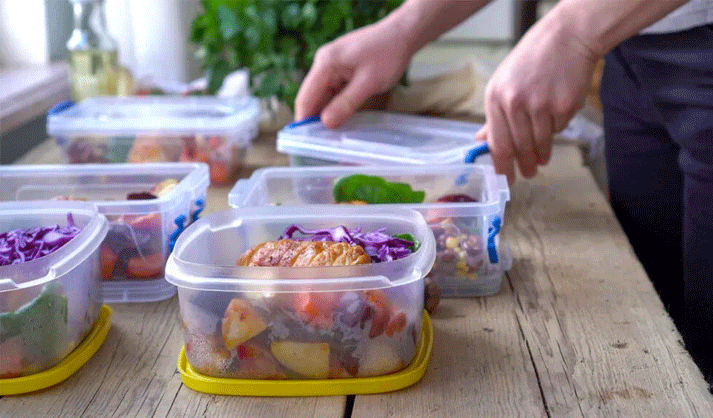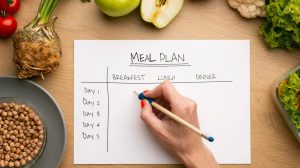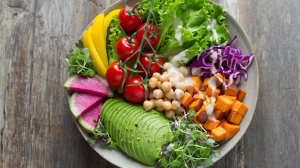Table of Contents
There has been too much focus on inefficient diet plans when it comes to weight loss lately. People have tried low carb, keto, fasting, paleo, and many more. Some of them result in a fast weight loss but are they really that effective long term? Are they beneficial for our health? Let’s have a look at how you can set up your own healthy, effective, and right diet for weight loss.
Why the Right Diet is Important for Weight Loss?
Most of us know that what we eat is a crucial part of how we look. If we eat plenty of junk food, we gain weight. Just as eating a “healthy” diet makes us lose weight and stay lean and aesthetic.
But is it really that simple?
Probably not.
Our bodies get energy from the food we eat, we call this a calorie. We need those calories for everything that we do, from lifting weights, running, or simply just existing. When we get more calories than we need, they’ll be stored, often as fat. When the body gets fewer calories than required, it’ll begin to use this stored energy. Again, often fat. This means that weight loss essentially can be described as calories in VS calories out.
The diet is important as it determines our calorie consumption and therefore is the most important factor for weight loss. However, to stay healthy and experience sustainable weight loss, focusing on calories alone won’t be enough.
You May Also Like: Best Exercises to Lose your Weight Fast
What do I Have to Consider in My Diet?
As mentioned above, the amount of calories we consume decides if we’re losing weight and how fast. However, there are other factors that are just important for the sustainability and health of weight loss.
Macronutrients
Macronutrients (macros) are a term for the three most important nutrients in our food, proteins, carbohydrates, and fats. All three are crucial for the body’s basic functions and all three should always be a part of a healthy diet.
Protein is especially important when comes to weight loss. If the protein consumption is too low, muscle mass will be lost. Having muscles makes the body burn more calories. If we lose them, we burn fewer calories, and losing weight will be even more difficult.
Eat your Greens
Vegetables and fruit should always be a part of a healthy diet. They are full of vitamins and fibers, which makes them crucial for our health. And they’re great when trying to lose weight as well.
Fruits and vegetables are a great way to make yourself feel full, even when in a calorie deficit. They’re low in calories, but the high amount of fibers makes them filling. It can even help reduce cravings.
How to Create the Right Diet for Weight Loss
We know that the two key components of a diet for weight loss are macros and calories. Let’s have a look at how to calculate your needed calories and find a macro ratio suitable for you.
Calculate your Needed Calories
The most important part of weight loss is to make sure that you eat fewer calories than your body burns. There are different ways to do this, but the easiest and most effective might be to calculate it. Especially if you’re not used to eating in a calories deficit.
First, you’ll want to calculate your BMR, which is how many calories your body needs for critical functions. There are many different ways to do this, but the most precise is the Mifflin-St Jeor equation. It can either be done by an online BMR calculator, or you can calculate yourself. The formula looks like this.
10 * weight (kg) + 6.25 * height (cm) – 5 * age (y) + s
s is +5 for males and -161 for females.
Once you have calculated your BMR, it’s time to include your activity level. Below is 5 different activity levels and how you can add them to your BMR.
BMRx1.2: If you’re sedentary, do little to no exercise in a day.
BMRx1.375: If you’re slightly active, with 1-3 light workouts a week.
BMRx1.55: If you’re moderately active, with 3-5 workouts a week with moderate intensity.
BMRx1.725: If you’re very active, with 6-7 high-intensity workouts a week.
BMRx1.9: If you’re extremely active. This could be if you have a physically demanding job alongside 6-7 intense workouts or if you’re working out twice a day.
Once you know how many calories you need, you can subtract 300-500 calories a day to lose weight.
Let’s have a look at the macro ratios before we get to an example.
Find your Macro Ratio
Now that we know how many calories we need, it’s time to find our macro ratio. Below is how much you need of the different macros in percentages.
Proteins: 30-35% of your total daily calories.
Carbs: 40-50% of your total daily calories.
Fats: 20-30% of your total daily calories.
Proteins and carbs contain 4 calories per gram, while fats contain 9 calories.
Now that we know how much of the diet should be filled with the different macros and how many calories they consist of, we can calculate the macro ratio.
Example
Now that we know how to calculate our needed calories and macro ratio, we can have a look at an example.
In our example, we’ll have a look at a guy who’s 24 years old, 186 cm tall, and weighs 80 kg. He has 6 high-intensity workouts a week. His goal is to lose weight.
First, he’ll want to calculate his BMR.
10 * 80 + 6.25 * 186 – 5 * 24 + 5 = 1847.5
Now we can add his activity level.
1847.5 * 1.725 = 3187
As his goal is to lose weight, we have to subtract 500 calories.
3187 – 500 = 2687
Now that we know that he needs to eat 2687 calories a day to lose weight, we can calculate his macro ratio.
Proteins: 30% of 2687 = 0.3 x 2687 = 806 / 4 = 202 g of protein a day.
Carbs: 45% of 2687 = 0.45 x 2687 = 1209 / 4 = 302 g of carbs a day.
Fats: 25% of 2687 = 0.25 x 2687 = 672 / 9 = 75 g of fats a day.
To experience a healthy and sustainable weight loss, our example needs to eat 2687 calories a day. He needs to eat 202g of protein, 302 g of carbs, and 75 g of fats a day to fuel his body and get the best results.
We are all different, and it’s important to remember that what worked for someone else might not necessarily work for you. Experiment with the ratios and calculations above to find the one suiting you the best.







